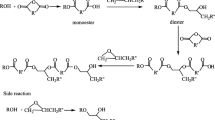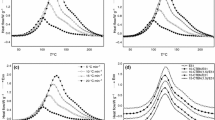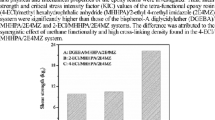Abstract
The effect of carbamate (urethane) groups on the curing reaction of an epoxy catalyzed by tertiary amine was studied by infrared (IR) and differential scanning calorimetry (DSC) analysis. It was found that the aromatic-connected carbamate (Ar-carbamate) accelerated the consumption rate of epoxy in the epoxy/tertiary amine/Ar-carbamate reaction system, where the tertiary amine and Ar-carbamate was found to form an active complex with stoichiometric ratio in the curing reaction. However, under the introduction of aliphatic-connected carbamate (Al-carbamate) into the reaction system, no complex formed with the tertiary amine during the reaction and therefore no acceleration in the reaction rate was observed.
Similar content being viewed by others
References
H. Lee and K. Neville,Handbook of Epoxy Resins, McGraw-Hill, New York, 1967.
E. H. Rowe,26th Ann. Tech. Conf. Reinforced Plastic/Composites Div. SPI, Sec. 12PEI, 1971.
C. B. Bucknall, T. Yoshi,Br. Polym. J.,10, 53, 1978.
L. H. Sperling,Interpenetrating Polymer Networks and Related Materials, Plenum Press, New York, P.99, 1981.
J. H. Sulton and F. J. McGarry,Polym. Eng. Sci., Polym. Phys.,28, 623, (1990).
K. H. Hsieh and J. L. Han,J. Polym. Sci., Polym. Phys.,28, 623, (1990).
K. H. Hsieh and J. L. Han,J. Polym. Sci,. Polym. Phys.,28, 783, (1990).
J. L. Han, S. M. Tseng, J. H. Mai and K. H. Hsieh,Angew. Makromol. Chem.,182, 193, (1990).
J. L. Han, S. M. Tseng, J. H. Mai and K. H. Hsieh,Angew. Makromol. Chem.,184, 89, (1991).
C. Hepburn,Polyurethane Elastomer, Applied Science Publisher, New York Wiley, 1982.
L. J. Bellamy,The Infrared Spectra of Complex Molecular, London Methuen Co. Ltd, 1954.
D. Dolphin and A. Wick,Tabulation oflnfrared Spectra Data, New York Wiley, 1977.
G. Socrates,Infrared Characteristic Group Frequencies, New York Wiley, 1980.
T. I. Kadurind, V. A. Prokopenko and S. I. Omelchenko,Eur. Polym. J.,22, 865, (1986).
J. Mijovic, A. Fishbain and J. Mijaya,Macromolecules,25, 979, (1992).
A. Vazquez, L. Matejka, P. Spacek and Dusek,J. Polym. Sci., Polym. Chem.,28, 2305, (1990).
D. S. Kim and S. C. Kim,Polym. Eng. Sci.,34, 625, (1994).
Author information
Authors and Affiliations
Rights and permissions
About this article
Cite this article
Han, J.L., Hsieh, K.H., Chiu, W.Y. et al. Effect of urethanes on base-catalyzed epoxy reaction. J Polym Res 2, 115–120 (1995). https://doi.org/10.1007/BF01493211
Issue Date:
DOI: https://doi.org/10.1007/BF01493211




